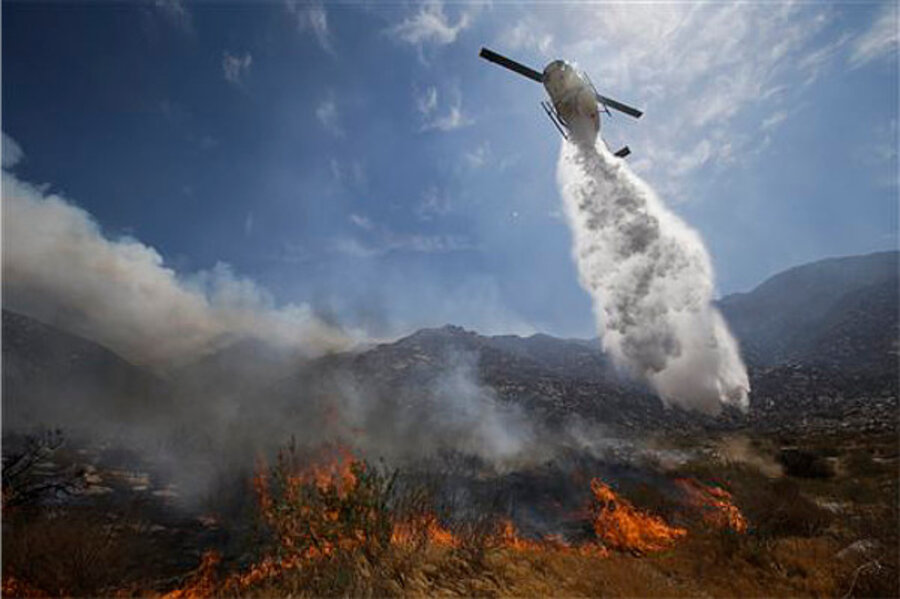California wildfire chases 1,500 from their homes
Loading...
| BEAUMONT, Calif.
A rapidly spreading wildfire chewed through a rugged Southern California mountain range on Thursday, destroying at least 10 homes, threatening more than 500 other residences and forcing some 1,500 people to flee.
Five people were injured, while more than 1,000 firefighters, 13 helicopters and six air tankers battled the flames as they pushed eastward along the San Jacinto Mountains, a desert range 90 miles east of Los Angeles, Cal Fire Riverside Chief John R. Hawkins said.
A man near the origin of the fire suffered serious burns, Hawkins said. Four firefighters were also injured, including two who suffered heat exhaustion. Officials did not have details to release on the other two.
At least 10 homes have been destroyed and Hawkins said that number would likely triple as authorities make their way into the charred areas to assess the damage.
Hawkins said the wind-fed fire that sparked at 2:05 p.m. Wednesday is one of the "most rapidly spreading, dangerous fires that I've seen" in his 50 years as a firefighter.
The fire was estimated at 17 square miles Thursday, with 10 percent containment, but it was growing, causing concern that the direction could change in the area, which is known as a wind tunnel.
"The conditions at the front right now are very dangerous," Hawkins said.
Authorities still have not determined what caused the fire.
Evacuation orders were issued in five towns. Flames were marching toward the hardscrabble town of Cabazon, where hundreds scrambled to leave in the pre-dawn hours Thursday as the mountain ridge behind their homes glowed red.
Many returned after sunrise to pack up more belongings and watch the flickering line of fire snaking along the brown, scrubby mountains.
Linda Walls, 62, sat with her family in lawn chairs and watched fire crews scrambling to douse the flames marching toward her modest home less than a quarter mile away. An American flag flapped in the gusty wind that kicked up the fire. She wiped her brow, feeling the scorching heat.
Gray and pink-tinted clouds billowed across the otherwise crystal blue sky. Neighbors could be heard coughing as they filled the beds of pickup trucks with motocross bikes, boxes of clothing, toys and packaged food.
"It seems to be taking off now," she said as sirens whirred by. "All you see are the firemen inside the blaze."
At the end of her street, a group of ostriches paced in their cages as the hill above them burned. A firefighter rushing by said they would do what they can to protect them. Nearby another pen was filled with goats.
In the nearby town of Banning, Lili Arroyo, 83, left with only her pet cockatiel, Tootsie, in its cage and a bag of important papers from her home, which was rebuilt after being destroyed in a 2006 wildfire.
"The smoke was so bad you couldn't see," said Arroyo, who lives in the town of Banning. "There were embers and ash coming down all over the sky. The smoke was really thick. I was starting not to be able to breathe."
Evacuation orders covered an RV resort called the Silent Valley Club, the rural communities of Poppet Flats, Twin Pines, Edna Valley and Vista Grande, portions of the city of Cabazon along Interstate 10, and a camping area known as Black Mountain.
A veteran of many evacuations, Dana Wright, 43, wiped away a tear as she entered a shelter at a Beaumont school and went with her family to watch TV news. She had no idea whether her Poppet Flats home of 11 years had survived. Friends said a nearby home had burned.
She and her husband hoped to find a way back up into the mountains. "I just want to look to see if we have a house," she said.
Most of Southern California's severe wildfires are associated with Santa Ana winds caused by high pressure over the West that sends a clockwise flow of air rushing down into the region.
This week's fire, however, was being fanned by a counter-clockwise flow around a low pressure area over northwest California.
It was the second major wildfire in the San Jacinto Mountains this summer. A blaze that erupted in mid-July spread over 43 square miles on peaks above Palm Springs, burned seven homes and forced 6,000 people out of Idyllwild and neighboring towns.
The latest fire also burned in the footprint of the notorious Esperanza Fire, a 2006, wind-driven inferno that overran a U.S. Forest Service engine crew. All five crew members died. A man was convicted of setting the fire and sentenced to death.
After touring the area, U.S. Sen. Barbara Boxer, D-Calif., who lives in Riverside County, said 165,000 acres have burned in California this year and climate change is setting conditions for more disastrous blazes, while budget cuts are limiting resources to fight them.
"Unless we take action, things are only going to get worse," she said.
A different blaze, a 45-acre wildfire, near Wrightwood in the San Gabriel Mountains forced evacuations of mountain communities Thursday afternoon.
The fire broke out around noon, and firefighters struggled to beat back flames in steep terrain. Homes along several winding mountain roads were being evacuated. It was unclear how many homes or residents are affected.
Wrightwood is a mountain community popular with skiers located about 40 miles northeast of downtown Los Angeles.
Associated Press writer John Antczak in Los Angeles contributed to this report.







